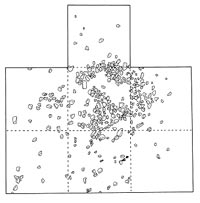Hickory Bluff Project

Come Explore Your Heritage. Dive Into The Past
Issue 5: Home is Where the Hearth Was?
This is a of what remains of a hearth feature at the Hickory Bluff site. When we use the word hearth, we usually think of a fire built for cooking, or for warmth and light. In fact, the actual use of a feature such as this is not always clear on first observation.
The rocks making up this hearth feature are scattered about, and are probably not in exactly the same places they were when the hearth was in use.

After the fire was put out and the site abandoned, the hearth may have laid open for many years. When people came back to the site in another season, they may have reused some of the stones for new fires elsewhere. They may also have kicked the stones around accidentally while walking across the area, or may even have moved some of them purposefully out of the way to avoid stumbling on them. Over the centuries, as the site became buried, tree roots may have grown through the hearth, or rodents may have burrowed through the area, in either case pushing the stones further from their original locations.
And so, it may be hard to determine at first glance whether this was the actual location of the hearth, or whether it was a place where rocks that were no longer needed were tossed to get them out of the way of other activities. How do we decide which it is?
To start, we look in detail at the rocks in the feature. Heating rocks can cause them to crack and eventually to break apart - this has led to the descriptive term fire-cracked rock for these artifacts. If the rocks in the hearth feature are in their original location, there is a good chance that some of the broken pieces can be fitted together to form portions of the original stones or cobbles. If none of the pieces fit together, it may be an indication that the fragments have been moved around since the hearth was used.
We can also look closely at what surrounds the rocks in the feature. Fire produces charcoal, and it can bake the ground beneath it, turning it hard and red. Remnants of charcoal or differences in the color and texture of the soil around the rock may indicate that there had been a fire on this spot.








